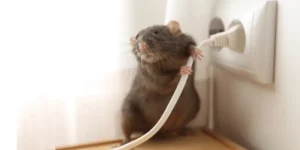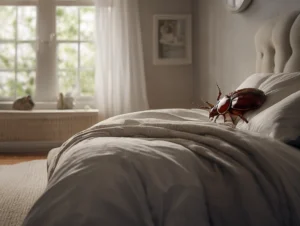Winter in Ontario brings more than just cold winds and snow. It also brings increased rodent and wildlife activity as animals desperately search for warm shelter, accessible food, and protection from harsh outdoor conditions. For many homeowners, the first sign of a problem happens when they begin hearing scratching sounds in the kitchen walls, scurrying behind baseboards, or unexpected noises in the attic at night.
These signs often cause worry—and for good reason. Rodents and wildlife can damage insulation, chew wiring, contaminate food, ruin stored belongings, and create fire hazards. Understanding why these animals invade and how to prevent them is essential for every Ontario homeowner.
This guide outlines the top three most effective techniques to keep rodents and wildlife out of your home, especially during the coldest months of the year. These are the same methods wildlife and pest-control professionals use, and they work for homes in all regions of Ontario, including rural, suburban, and city neighborhoods.
Why Homeowners Hear Scratching in Walls or Noise in the Attic During Winter
Before diving into prevention, it helps to understand why these noises occur and what they mean. These are the same questions Ontario homeowners frequently search on Google, and they’re important keywords for winter pest and wildlife protection.
Why You Hear Scratching in the Kitchen Walls
Scratching sounds in walls—especially at night—almost always point to mice or rats. When temperatures drop, these rodents squeeze into tiny gaps around your home and take shelter inside wall cavities. Kitchens are their favourite area because food smells, crumbs, and warmth attract them.
Rodents commonly enter through:
- Gaps behind cabinets
- Openings around plumbing pipes
- Dryer vents and kitchen exhaust vents
- Cracks in siding or brickwork
- Small holes in the foundation
Mice can fit through a hole the size of a dime, making it easy for them to slip inside if even one small gap is left unsealed.
Why You Hear Noise in the Attic at Night
Attic noises can come from several types of animals. The type of sound you hear often gives clues:
- Fast, light scurrying: mice or squirrels
- Slow, heavy thumps: raccoons
- Fluttering or squeaks: bats
- Rolling or dragging: larger wildlife building a nest
Attics offer warmth, insulation for nesting, dryness, and safety from predators—exactly what animals want during winter.
Why Winter Increases the Risk of Invasion
Ontario winters can be harsh. Food becomes scarce, nights are long, and temperatures fall to dangerous lows. Rodents and wildlife follow natural instincts to survive by finding:
- Heated indoor spaces
- Shelter from wind and snow
- Reliable food sources
- Dark areas to breed and nest
This means your home becomes the perfect refuge unless it’s properly protected.
Method 1: Exterior and Interior Sealing (The Most Important Prevention Step)
The most effective way to stop a winter infestation is to eliminate every possible entry point animals could use. This method is known as exclusion, and it is the foundation of long-term rodent and wildlife prevention.
What Exterior Sealing Includes
Exterior sealing involves identifying and closing any weak spots on the outside of your home. Common vulnerable areas include:
- Cracked foundation openings
- Gaps around windows and door frames
- Holes where utility lines enter
- Unprotected attic vents
- Loose or damaged soffits and fascia
- Openings around rooflines
- Gaps under siding
- Damaged brick mortar
- Uncovered exhaust vents
Rodents and wildlife are extremely determined when seeking shelter. Even a tiny gap can be an easy entry point.
Materials Used for Professional Exclusion
Typical homeowner-grade caulk or foam is insufficient to deter strong chewers or animals capable of tearing through wood. Professionals often use:
- Steel mesh
- Galvanized metal sheets
- Wildlife-proof vent covers
- Heavy-duty rodent-proof sealants
- Hardware cloth with tight openings
- Reinforced chimney caps
These materials can withstand chewing, clawing, and weather exposure.
Interior Sealing Is Just As Important
Once inside, rodents travel through wall cavities, behind appliances, and along plumbing lines. Interior sealing closes off these routes and prevents rodents from accessing the kitchen, basement, and pantry.
Common indoor areas that require sealing include:
- Gaps under kitchen cabinets
- Openings behind the stove or fridge
- Holes around pipes under sinks
- Basement utility rooms
- Furnace and water heater areas
- Laundry room wall penetrations
Interior sealing helps stop rodents from spreading once inside, and combined with exterior sealing, it creates a strong, multi-layered barrier.
Why Sealing Works Better Than Traps Alone
Traps may catch a few rodents, but they won’t stop more from entering if there are open gaps around your home. Sealing blocks entry entirely, making it the most effective long-term strategy.
Method 2: Removing All Food, Water, and Shelter Attractants
Rodents and wildlife don’t invade homes randomly. They choose houses that offer easy food, warmth, and shelter. Removing these attractants makes your home far less appealing.
Indoor Attractants That Bring Rodents Inside
The kitchen is the number one area that attracts mice and rats. Common attractants include:
- Food left on counters
- Crumbs around the stove
- Open garbage bins
- Pet food left out overnight
- Bread, cereal, and snacks stored in thin plastic bags
- Spills inside cabinets
- Grease buildup behind appliances
Rodents have an excellent sense of smell and can detect food from far away. Tightening up food storage and cleanliness significantly reduces the chance of invasion.
Outdoor Attractants That Invite Wildlife
Outside, many things can bring larger animals close to your home:
- Bird feeders
- Garbage left accessible
- Compost without secure lids
- Pet food dishes on the porch
- Overgrown vegetation against the house
- Firewood stacked near exterior walls
Squirrels, raccoons, and skunks often begin by exploring the outside of a home before finding an entry point. Removing outdoor attractants lowers that risk.
Why Attics Become Wildlife Hotspots in Winter
Attics provide:
- Constant warmth
- Darkness
- Soft insulation for nesting
- Quiet space away from people
- No natural predators
Once a wild animal establishes a nest in your attic, the damage can be significant—torn insulation, urine contamination, wiring damage, and larger entry holes created by the animal itself.
How to Reduce Attractants Indoors
- Store all food in airtight containers
- Clean floors and counters each night
- Seal garbage tightly
- Keep pet food stored securely
- Wash dishes before bed
- Clean behind appliances regularly
How to Reduce Attractants Outdoors
- Secure garbage bins with locking lids
- Move firewood at least 20–30 feet away
- Trim tree branches away from the roof
- Avoid leaving food outside
- Keep compost sealed
- Clear debris from around the foundation
These simple habits drastically reduce wildlife activity around your home.
Method 3: Monitoring, Detection, and Professional Prevention
Even with sealing and attractant control, Ontario’s winter pressure can still lead to pest activity. Monitoring and early detection help prevent small problems from turning into full infestations.
Signs of Early Rodent Activity
Homeowners should watch for:
- Scratching or tapping behind walls
- Droppings under sinks, near appliances, or in the basement
- Chewed food packages
- Grease marks along baseboards
- Urine odors
- Shredded paper or insulation
Signs of Early Wildlife Activity
Warning signs include:
- Heavy thumping or slow movement in the attic
- Damage to the roof shingles or soffits
- Torn garbage bins
- Footprints in the snow around entry points
- Strong odors from raccoon latrines
- Scratching or chewing sounds near the roof corners
Tools Professionals Use for Effective Prevention
Professionals rely on methods that are safe, targeted, and legal. Some tools include:
- Rodent bait stations placed outside the home
- Interior monitoring traps to check for activity
- Wildlife-proof one-way doors (for legal eviction)
- Thermal cameras to detect hidden animals
- Full attic inspections for damage or nesting
- Professional-grade exclusion materials
Why DIY Wildlife Removal Can Be Dangerous or Illegal
Attempting to remove wildlife without training can lead to:
- Animals getting trapped inside walls
- Aggressive behaviour from raccoons or squirrels
- Fire hazards from chewed wires
- Baby animals left behind
- Ontario wildlife law violations
Professional technicians understand local by-laws, humane removal methods, and how to prevent re-entry safely.
Additional Winter Protection Tips for Ontario Homeowners
To further reduce the risk of winter invasions, consider these extra tips:
Seal the Garage
Garages often have gaps around the door frame, creating a perfect entry point that leads directly into the home.
Reinforce Roofline Weak Spots
Soffit returns and roof corners are favourite access points for raccoons and squirrels.
Install Wildlife-Proof Chimney Caps
Chimneys attract squirrels, raccoons, and even birds looking for a warm nesting area.
Inspect the Foundation Regularly
Small cracks can quickly become rodent highways if left unattended.
Final Thoughts: Protect Your Home Before Winter Wildlife Moves In
Rodent and wildlife invasions spike in Ontario every winter as animals search for warmth and food. If you’ve been hearing scratching noises in the kitchen walls or strange sounds in the attic at night, it’s important to take action early.
The most effective winter protection plan includes:
1. Sealing all exterior and interior entry points (exclusion work)
2. Removing all indoor and outdoor attractants
3. Monitoring, early detection, and professional prevention
By combining these three methods, you create a powerful defense system that keeps rodents and wildlife out of your home—not only for one winter, but for years to come.







